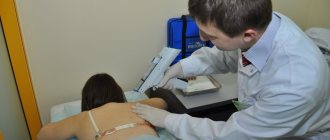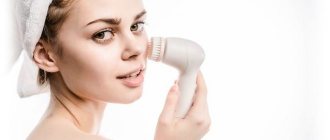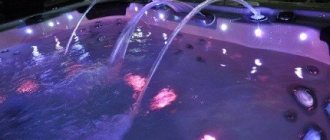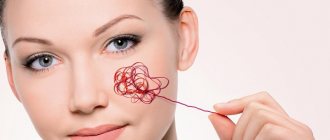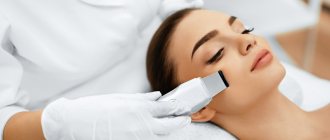What is mesotherapy
The procedure consists of intradermal administration of medicinal and vitamin preparations in low doses. This is a minimally invasive injection technique that allows you to eliminate many aesthetic problems of the face, body, and hair. After it, the skin is transformed, the skin becomes tightened and elastic.
Mesotherapy is carried out as a separate manipulation or part of cosmetic procedures. The drugs are administered with the thinnest needles to a depth of 1.5-13 mm, this depends on the area of work. At the age of 18 to 25 years, facial mesotherapy is more often performed to get rid of oily skin, acne and its consequences. After 25, it acts as a prevention of aging.
An improvement in skin condition is noted after the first session, but a course of treatment is required to solve aesthetic problems. The number of visits is selected individually. From 4 to 15 procedures may be required at intervals of 6-10 days. To get rid of cellulite, up to 15 sessions are required, to restore the oval of the face - up to 8, to eliminate bags under the eyes - up to 4.
Insidious rosacea
The strange word “cooperosis” has French roots and is translated as “copper rose”. And although the name of this common disease of the epidermis is romantic, in its neglected state it looks completely unaesthetic. The skin is covered with red or bluish veins, intertwined into intricate meshes.
But this is only the visible part of the problem. Much worse is that such a pattern indicates the fragility of blood vessels. This means that at the slightest negative impact they are destroyed. Skin cells do not receive enough nutrition, and its condition quickly begins to deteriorate. She ages rapidly, becomes dry, and sensitivity decreases.
Therefore, you need to start fighting rosacea as soon as its first symptoms become noticeable: small red dots or stars appear under the skin. These are the junctions of capillaries in which normal blood flow is disrupted. Later, the stars turn into veins and gradually spread across the face.
What is the difference between mesotherapy and biorevitalization
The methods are very similar, but differ in the composition of the agents and the method of administration. For biorevitalization, gel-like preparations based on hyaluronic acid are used. Due to their dense consistency, they fill obvious wrinkles well, so the procedure is recommended for people over 30 years old.
During mesotherapy, liquid cocktails that contain various substances are administered. The cosmetologist selects the composition taking into account skin problems, age, and wishes of the client. They may also contain hyaluronic acid , but its amount will be significantly less than for biorevitalization. Due to the liquid form of the drugs, it will not be possible to fill deep wrinkles and folds. Due to the multicomponent composition, the range of indications for mesotherapy is wider.
Mesotherapy and biorevitalization can be used as two complementary procedures. They help improve skin condition, but have a different spectrum of action.
Traditional medicine or treating rosacea at home
Skin prone to rosacea can also be treated at home. There are special folk recipes that will help eliminate this deficiency. Among folk recipes, it is worth highlighting oils for rosacea. Rosemary oil is especially beneficial for the skin . Thanks to its tonic effect and ability to stimulate blood circulation, rosemary is able to restore firmness and elasticity. You can use rosemary oil at home by regularly applying rosemary to the affected area. Herbs are also used for rosacea, for example, lotions are made from calendula and chamomile .
Our grandmothers used honey . They made face masks with honey, which helped soothe the skin, and honey improved blood circulation. Or you can simply apply pure honey to your face and leave for 10 minutes, then rinse off. For greater effectiveness, you can add aloe juice to honey.
Pros and cons of mesotherapy
The main advantage is the safety and non-toxicity of the drugs used, which extremely rarely cause side effects. Other advantages:
- wide age range;
- combined with other cosmetic procedures;
- minimal list of contraindications;
- persistent, long-lasting effect;
- suitable not only for women, but also for men;
- performed on an outpatient basis.
One of the disadvantages is the need for several sessions - from 4 or more, which depends on the problem being solved. After injections, slight swelling and discomfort at the injection site are possible, but this should not be a cause for concern.
What therapeutic effect does mesotherapy have?
The result is noted due to 2 factors: delivery of active components to the skin and the mechanical effect of the needle. At the injection site, many microtraumas appear, which trigger the production of their own elastin and collagen, as a result of which microcirculation and metabolic processes improve. Depending on the task and the composition of the cocktails, the following effects are noted:
- the elasticity and firmness of the skin increases;
- hair growth increases;
- the functioning of the sebaceous glands is normalized;
- Spider veins are eliminated and blood vessels are strengthened;
- dark circles and bags under the eyes disappear;
- The oval of the face is tightened, fine wrinkles and sagging skin are eliminated;
- pigment spots are eliminated;
- enlarged pores are narrowed, acne and its consequences are eliminated.
The cosmetic procedure smoothes out the “orange peel” and evens out the skin. It is effective in the presence of stretch marks, scars, scars due to stimulation of tissue regeneration.
Areas of application of mesotherapy
The procedure can be used to eliminate aesthetic problems on any part of the body. Mesotherapy application areas:
- Body.
- Face.
- Hair and scalp.
- Eyes (eyelids, area around the eyes, bags and dark circles under the eyes).
- Stomach.
- Neck.
- Chin.
- Hips, buttocks.
- Chest (neckline area).
- Hands.
- Legs.
- Back.
- Nose and nasolabial folds.
- Lips.
- Vessels.
The low invasiveness of the procedure allows it to be used even on areas with thin and sensitive skin. It can be combined with other therapeutic and surgical techniques within the framework of aesthetic medicine.
Mesotherapy shows high effectiveness for baldness. According to reviews of people who have undergone the procedure, after 10-13 sessions, activation of the hair follicles is noted.
Indications and contraindications for mesotherapy
Mesotherapy is performed as a therapeutic and preventive procedure from the age of 18. This is a universal and effective manipulation that has a wide range of indications:
- rosacea;
- acne (acne vulgaris, rosacea);
- stretch marks;
- scars;
- bags, circles under the eyes;
- sagging, decreased skin tone;
- dark spots;
- wrinkles;
- swelling;
- oily, porous skin;
- cellulite;
- alopecia (hair loss).
Injections can serve as a preparatory step before other cosmetic procedures or during the recovery period after them. The procedure has a number of limitations:
- pathology of the coagulation system;
- intolerance to substances contained in the drug;
- pregnancy;
- tendency to form keloid scars;
- breast-feeding;
- period of exacerbation of chronic diseases;
- severe inflammatory process, fungal infection, open wounds in the work area.
Injection mesotherapy is not recommended when taking antiplatelet agents or anticoagulants due to their effect on the blood coagulation system. Time restrictions: menstruation, recent deep peeling, respiratory diseases.
Acids allowed for rosacea
There are so-called fatty acids that do not have an aggressive effect on rosacea and can easily be included in any preparation. You should not be afraid of them; on the contrary, their presence in creams and lotions prevents the appearance of dryness, relieves irritation, and helps cope with acne, peeling, and other skin imperfections. They stimulate collagen production and are antioxidants, that is, substances that can fight the harmful effects of the environment.
The most common omega3 fatty acids are alpha lipoic acid, while omega6 fatty acids are arachidonic acid and linoleic acid. These substances are found in oils of natural origin, such as flaxseed, nuts, soybeans and other healthy foods. For those suffering from rosacea, they are not only not harmful, but also extremely useful.
Since rosacea can be considered the first stage of rosacea, azelaic acid can be considered an excellent remedy for its treatment. It does not cause irritation, reduces sebum production, helps cleanse pores and get rid of comedones - “blackheads”, helps with juvenile acne, as it has a pronounced antibacterial effect. This product is not contraindicated for dry skin, as it evens out uneven surfaces, smoothes wrinkles, removes hyperpigmentation, and fights demodicosis. The use of creams and other preparations with it in the composition for rosacea is not contraindicated, and in the case of the above problems, it is even recommended.
Many women believe that if they have spider veins on their face, using any peels is strictly prohibited. In fact, this is far from the case. You should not use mechanical peelings in any form, that is, scrubs. They can damage the surface of the skin and provoke further expansion of capillaries, which only enhances the development of rosacea. In some situations, a cosmetologist can perform short-term (no more than 3 minutes) peeling with coral chips.
The approved ones include soft and gentle enzyme peels. They can be used even at home, only without excessive fanaticism, with gentle movements, followed by high-quality care. Such preparations contain enzymes and enzymes that gently and delicately dissolve the surface layer of dying cells, as well as sebaceous plugs in the pores, blackheads, reduce inflammation and acne. Since they are not aggressive and do not have a physical effect, they are allowed to be used even on sensitive skin and in the presence of various vascular diseases, for example, in the initial stages of capillary damage.
Among the permitted agents you can use weak concentrations of the following substances:
- Succinic acid is actively used for rosacea, as it can strengthen blood vessels, reducing the visibility of mesh and stars. After using this peeling, the skin looks fresh, brightened, the relief is smoothed, and blood microcirculation in the skin is greatly enhanced. The drug can also be taken orally to enhance the effect, but it has contraindications and can lead to side effects.
- Lactic acid has a gentle effect, so it is used for sensitive skin with rosacea and a tendency to allergic reactions. This substance successfully lightens the skin, makes it denser, stronger, strengthens blood vessels, reducing the visibility of the vascular network. Low concentrations can also be used in home peels, for example, as part of a serum, if the skin reacts adequately.
- Glycolic acid in low concentrations can be used in creams and serums if the skin tolerates it well. For peelings, a more concentrated acid is used, so such manipulations can only be carried out in beauty salons or offices, after consultation with an experienced specialist. In this case, the degree of development of rosacea should be minimal. For large affected areas, strong peeling is not used. This product has very small molecules that easily penetrate deep into the skin. Renewing it can significantly reduce the number and severity of noticeable vessels.
- Ascorbic acid, or vitamin C, is one of the best remedies for treating rosacea. It is added to various cosmetics, creams and serums, and taken orally. When using vitamin C, it is necessary to protect the skin from sun rays with high SPF creams, as it can stimulate the appearance of hyperpigmentation during irradiation.
- Nicotinic acid has a positive effect on dilated blood vessels. It can be used not only in the form of peels and serums, but also internally, in tablets. The drug is taken in courses, as prescribed and under the supervision of a doctor, since the drug can cause health problems. Nicotine is used to treat not only skin problems, but also many other diseases, for example, cerebrovascular accident accompanied by tinnitus, and many others. However, abuse of the drug can cause a negative reaction, so you need to choose low concentrations and monitor changes in your health.
- Mandelic acid acts quite carefully and can be used.
- Retinoic acid. This is the so-called “yellow peeling”, which is often prescribed to young women to improve skin condition and reduce the appearance of rosacea.
- Phytic acid has a large molecule size, so it is not able to penetrate deep into the skin. Procedures with it are prescribed to people with severe signs of skin aging and problems with blood vessels, since phytic acid has a superficial effect and cannot increase the appearance of noticeable capillaries.
Prohibited acids
In most cases, it is believed that fruit acids can cause harm in the presence of dilated blood vessels and stars on the skin. However, as with many other acids, everything is relative. Small concentrations are not capable of causing serious harm to the skin with rosacea if it is sufficiently dense, thick and oily. But with very thin, fragile, aged and dry skin, even creams with acids can lead to an exacerbation of the disease, thinning of the skin and turning it into “parchment”. So it is impossible to say completely unambiguously - this is possible, but this is not.
Oily skin with acne, blackheads and minimal manifestations of rosacea will appreciate the use of products with a low acid content, but for dry and aging skin with rosacea AHA acids are a real disaster.
The same applies to the use of peels. If there are vascular disorders, you can use only approved enzymatic or enzymatic peels, and only after talking with a cosmetologist. Among acid peels, surface preparations with low concentrations are acceptable, taking into account the skin type and its condition. Medium peelings are carried out only by the decision of a cosmetologist and in case of mild vascular damage. Their frequency should be minimal, only when necessary.
Mesotherapy techniques and methods
Methods differ in the method of administering drugs to the treated area:
- Pinpoint (“prick by prick”) is a classic, easy-to-perform technique. The drug is administered with a needle at a right angle to a depth of 4 mm at a distance of 1.5-2 cm.
- Nappage (“coating”) – quick injections at an angle to the surface of the skin. The needle is inserted to a depth of 1 to 4 mm, which depends on the type of nappage: superficial, middle or deep. The distance between injections is 3 mm.
- Papular. The needle is inserted at an angle to a depth of 1-2 mm to form small papules (tubercles).
- Linear. More often practiced for the treatment of scars and stretch marks. The needle is directed tangentially, the drug is injected retrogradely to fill the dermis under the wrinkle, fold of skin.
- Infiltration. It is used primarily to get rid of excess fat deposits (orange peel treatment). The needle is inserted to a depth of up to 13 mm every 2-2.5 cm.
In therapeutic mesotherapy, the continuous infusion technique is used to relieve pain in arthritis and arthrosis.
Hyaluronic acid for rosacea
Hyaluronic acid for rosacea, is it possible to use it and is it safe? In fact, a solution of hyaluronic acid is able to distribute well on the surface of the skin. Moreover, it thus forms a thin film that absorbs all the moisture from the air. This method allows you to saturate the stratum corneum of the skin with free water, as well as create the effect of additional moisture.
That is why hyaluronic acid is widely used in the treatment of rosacea. The fact is that it can relieve excess redness and help soothe the skin.
But you should not use this acid yourself. It is still advisable to consult a doctor regarding this issue. Because treatment of rosacea must be comprehensive. Hyaluronic acid cannot “fit” into any method or method of treatment. Therefore, some caution needs to be exercised. It is better to give preference to moisturizing creams. After all, the solution can be “prepared” incorrectly and in this way will only worsen the situation.
Types of mesotherapy
There are two types of procedure: injection and non-injection. In the first case, active substances are delivered to the skin using ultra-thin needles manually or using hardware. “Manual” mesotherapy allows you to work in the most delicate areas with thin skin, the drug is used sparingly.
Automatic injectors (guns) are suitable for working on a large area of skin (buttocks, thighs, abdomen, etc.). They facilitate and speed up manipulation, helping to quickly work on a large area in a short period of time. The device provides the exact depth of needle insertion and volume of the drug.
The second type of mesotherapy is the introduction of meso-cocktails without the use of needles. The active ingredients penetrate the skin through laser irradiation, magnetic and electric waves, and oxygen treatment. The method is ideal for people who want to undergo a rejuvenating procedure, but are afraid of injections.
Facial massage for rosacea
Facial massage for rosacea is effective in its own way. The point is that it needs to be done in a special way. In some cases, massage is prohibited, because such a procedure alone can only worsen the general condition of the skin.
One of the most recommended types of such influence is Spanish modeling. Use it exclusively for the neck and face. During this procedure, a deep study of the central part of the muscle occurs. Naturally, the greater impact is on areas of low tone. Due to this, the skin is strengthened.
In case of rosacea, plastic facial massage is also allowed. Only this procedure does not involve the use of creams or oils. A characteristic feature of this method is the performance of strong, rhythmic and pressing movements.
Massage is used only if a person’s skin is exhausted, and swelling and puffiness are also observed. In general, treatment of rosacea using this method is effective, but requires an individual approach.
[5]
Complications, side effects and consequences of mesotherapy
An allergic reaction to the administered substances is possible, which can manifest itself as severe swelling of the skin, itching, and hives. Other negative effects:
- Pain. When the drugs are administered, there is pain and sometimes a burning sensation, which is associated with irritation of skin receptors. If necessary, the cosmetologist administers local anesthesia using gels.
- Redness. Normal reaction to injection. The redness disappears within half an hour, maximum after 2-3 hours.
- Bruises. They occur due to damage to blood vessels during the injection. They dissolve from 2 days to 2 weeks depending on the area of the skin , the condition of the vascular wall, and the degree of fragility of the blood vessels.
Minor swelling is possible - the body’s natural response to skin injury; it goes away on its own within 1-2 days.
Essential oils for rosacea
Essential oils for rosacea perfectly remove all troubles on the face. Rosemary is so wonderful. It can tone, improve blood circulation, and make the skin elastic and firm. In addition, thanks to rosemary oil, water balance is regulated. To prepare such a wonderful remedy, you need to take 2 drops of the main ingredient and mix it with a spoonful of milk thistle oil. This remedy is used at night.
Geranium essential oil can also soothe the skin, relieve irritation, remove hypersensitivity and eliminate damage. In addition, external manifestations of rosacea are easily eliminated. This oil has remarkable whitening properties.
There are no restrictions when using essential oils. They are quite suitable for many people. True, it is prohibited to use them if there is an allergy. Treatment of rosacea in this case can be harmful.
Preparations, remedies and medicines for mesotherapy
Taking into account the principle of action, mesotherapy drugs are divided into several groups: vitamin, vascular, lifting, anti-inflammatory, lipolytic. The composition may include:
- dimethylaminoethanol;
- lipolytics – liporcil, silicine, lopocat, phosphodithylcholine;
- vitamins – A, C, E, B;
- acids – glycolic, pyruvic, hyaluronic;
- plant extracts – aloe vera, green tea, guarana, artichoke;
- minerals – silicon, magnesium salts, zinc, selenium;
- antibiotics, anti-inflammatory drugs;
- extracts of animal origin - elastin, peptides, collagen, etc.
The specialist selects the composition of the cocktail individually, taking into account skin type, main problems, age and other factors.
Recommendations for patients
After the injections, the cosmetologist gives recommendations for the recovery period, which takes an average of 3-5 days:
- do not visit the sauna, bathhouse, solarium;
- do not sunbathe in the sun;
- do not perform peelings, massages and other procedures that involve mechanical impact on the skin;
- limit physical activity.
After the procedure, you should stop drinking alcoholic beverages, as they promote vasodilation. It is recommended to use sunscreen before going outside. In the first days, treat the skin with chlorhexidine and healing gels. Decorative cosmetics, especially foundation, should be discarded in the first 2 days so as not to irritate the skin and provoke inflammation.
It is not recommended to take blood thinning medications (aspirin, etc.) for 2 days after injections.
Treatment of concomitant diseases and disorders in patients with rosacea
Treatment of concomitant diseases or elimination of provoking factors are one of the key stages in the management of patients with rosacea [1].
Hormonal disorders
Apparently, the manifestations of the vascular component in rosacea are largely due to hormonal disorders. The complex of hormonal influences on the condition of blood vessels (estrogens, progesterone, etc.) is well known. In particular, increased blood flow in the facial skin, as well as venous stasis, can cause persistent erythema, which explains the frequency of rosacea in middle and older age groups in women [2]. Hormonal examination and consultation with a gynecologist-endocrinologist is an important step in the rosacea treatment program.
At the same time, dermatologists prescribe external products containing vitamin K, ascorbic acid and other drugs to strengthen the vascular wall, as well as agents that improve lymphatic drainage (for example, caffeine derivatives).
Disturbance of intestinal microbiocenosis - dysbiosis
Dysbiosis, a pathological condition of the intestinal flora, has been found to influence the course of rosacea. The main localization of rosacea is the central areas of the face. A parallel can be drawn with juvenile T-shaped acne, where there is a similar localization of the rashes, and in which gastrointestinal pathology is detected. The role of dysbiosis in rosacea, its identification and correction is an important issue that requires a separate serious discussion.
I would like to draw your attention to the fact that dermatologists, when jointly managing dermatological patients with a gastroenterologist, sometimes encounter superficial, ineffective treatment of dysbiosis.
According to gastroenterologist Professor Shatikhin, dysbiosis is very often treated without taking into account or diagnosing the underlying pathology or the true nature of changes in microbiocenosis. The selection of therapy is carried out empirically. The result is low effectiveness of treatment [3]. And for dermatologists, this means a decrease in the results of treatment of skin pathologies or unstable remission.
Infectious diseases (helminthiasis, giardiasis)
According to WHO, the number of patients with intestinal helminthiases, the most common socially significant infectious diseases, reaches 1.4 billion people per year. In Russia, about 2 million patients with parasitic diseases are registered annually [4]. The number of clinically significant species of parasites, including intestinal protozoa, in particular Giardia, is increasing [5].
Treatment of giardiasis in complex therapy of acne and rosacea provides not only a faster clinical effect, but also stable remission of the disease [6].
Metronidazole
, a nitroimidazole derivative, which is the drug of choice in the treatment of trichomoniasis, amebiasis and giardiasis, has long established itself as an effective remedy in the treatment of rosacea.
There is still no consensus on the mechanism of action of the drug, and it is not clear which of its pharmacodynamic properties plays a leading role in achieving a clinical effect in the treatment of rosacea. It has been established that metronidazole enhances the protective and regenerative functions of the mucous membrane of the stomach and intestines, and also has a pronounced anti-edematous effect [7]. The drug provides a bacteriostatic effect against gram-negative anaerobic bacilli, Giardia, as well as an antiparasitic effect against Demodex folliculorum
.
Evidence that metronidazole, when administered systemically, has a suppressive effect on Demodex folliculorum
on the skin, has not yet been confirmed. Local use of drugs (lotions, gels) with metronidazole is quite effective.
Individual food intolerance
In recent years, there have been reports of good results in the treatment of a number of skin diseases using a diet that consists of excluding for a certain period a number of foods to which there is an individual intolerance. Food intolerance is often asymptomatic. In this case, the body receives products that it cannot fully process, which leads to a decrease in immune defense.
Immune status disorders (allergies, autoimmune thyroid pathology)
Allergic concept of rosacea.
With the development of rosacea, manifestations of sensitization to certain products, to
Demodex folliculorum
, helminths and protozoa, to the bacterial flora of the intestine, to fungi of the genus
Candida
, etc., are not excluded. The disease is most severe in the case of autoimmune pathology of the thyroid gland.
Prescribing antihistamines and homeopathic medications with simultaneous treatment by appropriate specialists
reduces the degree of allergic reaction and increases the effectiveness of rosacea treatment.
Nervous system disorders
Psychological stress, vegetoneurosis, excessive emotionality, and vulnerability often accompany patients with rosacea and require separate mandatory correction, including using traditional methods: homeopathy, hirudotherapy, bioresonance therapy, etc.
Reflex reaction of the skin
The energy connections between the skin and internal organs and the spine are taken into account. The reaction of “nerve irritation” (from mesotherapy, massage, ozone therapy, etc.) from the skin is carried out along nerve pathways to the pathological focus in a particular organ. This connection, of course, also works in the opposite direction. Therefore, for any skin disease or disorder, it is necessary to exclude a reflex reaction when dermatological manifestations serve as a signal of a disorder or disease of any internal organ. If we are talking about such a case, the internal organ should be treated. Skin symptoms will go away faster or disappear on their own [8]. At the same time, we see a good effect when using antihomotoxic (homeopathic) complexes
: Traumel comp., Zeel comp., Coensim comp., Ubichinon comp., Cutis comp., Discus comp. and etc.
Where can you get mesotherapy in the Russian Federation?
Mesotherapy is one of the most popular procedures performed by cosmetologists in medical or cosmetology centers. When choosing a clinic, you need to pay attention to the availability of the necessary licenses to carry out this activity, as well as a diploma from a specialist.
Before mesotherapy, it is recommended to clarify which drug manufacturers the institution works with, view photos of the work, and a description of the procedure. The price of clinic services depends on the drugs used, the number of injections and the area of influence.
Mesotherapy is an effective cosmetic procedure. It solves a number of problems with skin and hair, while avoiding surgical intervention . The result can last up to 1.5 years; it is recommended to repeat the course once a year.




